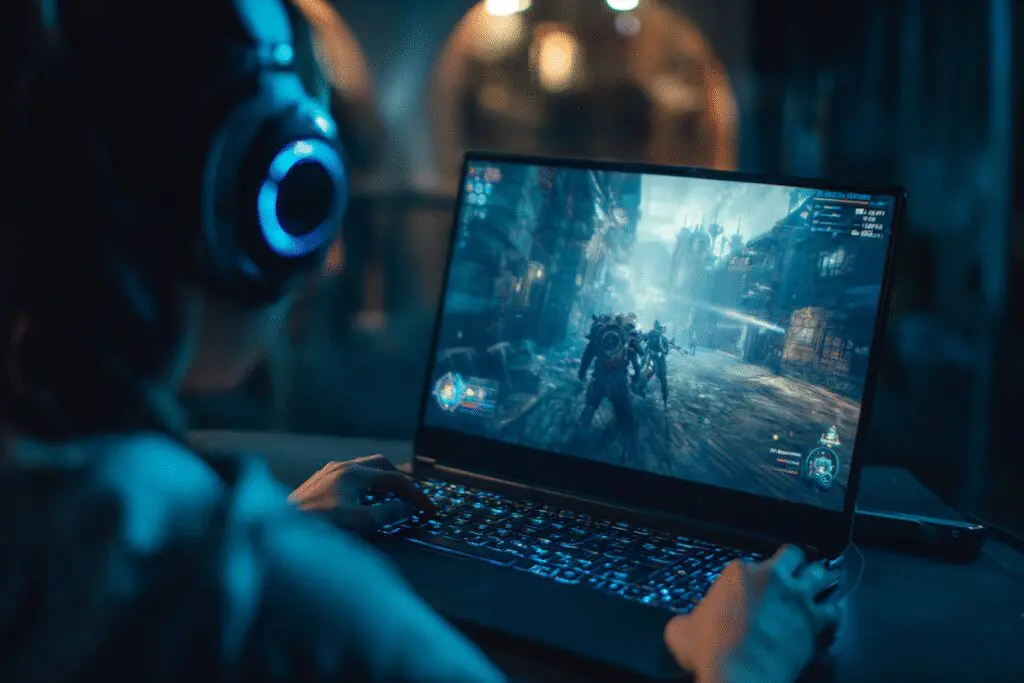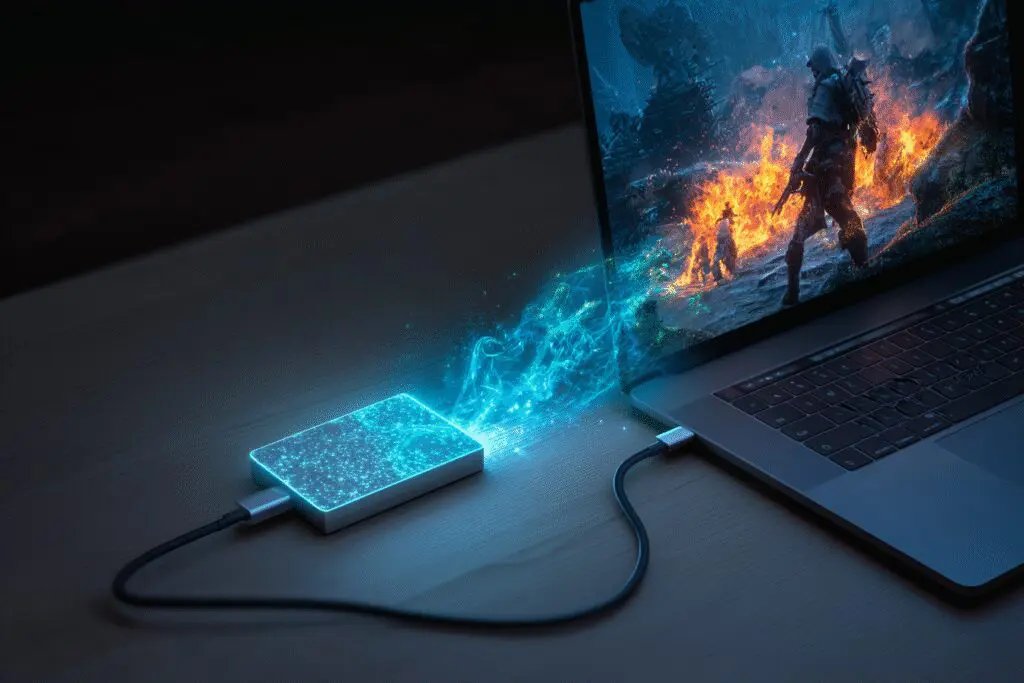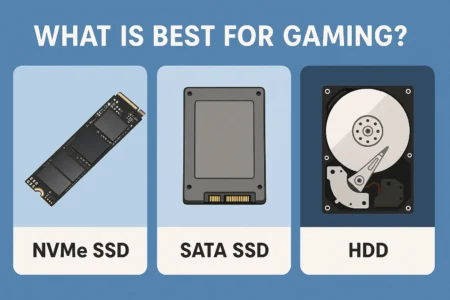Let’s cut right to the chase: Yes, external SSDs are not just good, but often fantastic for gaming. But—and this is a big but—it all comes down to the connection. Think of it like having a supercar stuck in city traffic. The drive itself might be screamingly fast, but if the pipeline connecting it to your PC or console is too slow, you’ll never feel that power. I learned this the hard way when my gaming laptop’s 1TB drive filled up after installing just a handful of modern titles.
The frustration of deleting one massive game to install another was real. That’s when I started looking into external storage, and it sent me down a rabbit hole of USB standards and performance claims. So, are external SSD good for gaming? Absolutely, provided you pay attention to the details that truly matter.
More in Motherboards & Storage Category
How to Tell If Motherboard Is Dead
How to Update Motherboard Drivers
Why Would You Even Need an External SSD for Gaming in the First Place?
It feels like just yesterday a 500GB hard drive was considered spacious. Now, games like Baldur’s Gate 3 and the latest Call of Duty installment can easily gobble up 150GB of space or more. Suddenly, that brand-new console or gaming PC’s internal storage feels incredibly cramped.
This is the primary reason gamers turn to external drives. You’re facing a digital storage crisis, and you need a simple solution without cracking open your computer case or performing surgery on your console.
The Problem of Modern Game Sizes
Digital game libraries are a fantastic convenience until you hit that dreaded “Not Enough Space” error. The cycle becomes exhausting: you want to try a new game, so you have to decide which of your current favorites gets deleted. It’s a constant juggling act that pulls you out of the fun and into a tedious management task. An external SSD immediately solves this by massively expanding your available library space.
Upgrading a Console’s Limited Storage
The PlayStation 5 and Xbox Series X/S come with incredibly fast internal NVMe SSDs, but their capacity isn’t infinite. Adding an external SSD is one of the easiest ways to keep more games installed and ready to play. While you might have to transfer PS5 games to the internal drive to play them (due to Sony’s requirements), the external drive acts as a super-fast “cold storage,” making the transfer process take minutes instead of the hours it would take to re-download. For PS4 games on a PS5, you can play them directly from the external SSD, saving that precious internal space for next-gen titles.
The Gaming Laptop Conundrum
Gaming laptops are powerful, portable machines, but they often come with a compromise: limited internal storage slots. Many models have only one or two M.2 slots. If you’ve filled them up, your only option for expansion is to go external. An external SSD lets you carry a massive Steam library in your backpack without needing to replace your internal drives.
What’s the Big Deal with USB Speed and Performance?
This is where the magic happens, or where it fails to. The speed of your external SSD is completely bottlenecked by the USB port it’s connected to. Plugging a high-performance drive into an old, slow port is like putting a leash on a cheetah.
To understand this, you need to know a little about the different USB standards. Don’t worry, I’ll keep it simple and focused on what it means for your game load times.
A Quick and Simple Guide to USB Generations
- USB 3.2 Gen 1 (Formerly USB 3.0): This is your baseline. It offers speeds up to 5 Gigabits per second (Gbps). For gaming, this is perfectly fine and a massive leap over any external mechanical hard drive (HDD). It’s fast enough to dramatically cut down load times in most games.
- USB 3.2 Gen 2: This standard doubles the speed to 10 Gbps. This is the sweet spot for most modern external SSDs, like the popular Samsung T7 or Crucial X8. It provides performance that gets very close to an internal SATA SSD, making it an excellent choice for a primary external games drive.
- USB 3.2 Gen 2×2: Things get a bit more confusing here. This standard hits 20 Gbps but requires both the drive and the port on your computer to specifically support it. It’s less common than the others, so you have to check your motherboard or laptop specs carefully.
- Thunderbolt 3 / Thunderbolt 4 / USB4: This is the top tier, boasting speeds of up to 40 Gbps. An external NVMe SSD in a Thunderbolt enclosure can deliver speeds that are virtually indistinguishable from an internal NVMe drive. It’s breathtakingly fast, but it’s also the most expensive option and requires your device to have a Thunderbolt port.
Honestly, I spent a couple of evenings just reading about USB standards on various tech sites and forums. The naming conventions are a mess, but the takeaway for gaming is this: aim for a drive and a port that support at least 10 Gbps (USB 3.2 Gen 2) for the best balance of price and performance.
What Kind of Real-World Gaming Performance Can You Actually Expect?
Benchmarks and theoretical speeds are great, but what does this mean for you when you’re actually loading into a game? How much faster will it really be?
Let’s break it down with a practical comparison. Imagine you’re loading a massive open-world game like Cyberpunk 2077.
External HDD vs. External SSD
This isn’t even a competition. It’s a complete knockout. An external mechanical hard drive might take over a minute to load a save file. An external SSD, even on a basic 5 Gbps USB connection, will likely slash that time to under 20 seconds. The difference is night and day. It’s the single biggest quality-of-life improvement you can make if you’re still using an HDD.
External SSD vs. Internal SATA SSD
Here, the race gets much closer. A good external SSD running on a 10 Gbps USB port will perform very similarly to an internal SATA SSD. You might see a difference of a second or two in load times, but in practice, you’d be hard-pressed to notice. The experience feels virtually identical, which is a huge win for the convenience of an external drive. I tried this myself, moving The Witcher 3 from my internal SATA drive to a new external one, and I honestly couldn’t tell the difference in my day-to-day playing.
External SSD vs. Internal NVMe SSD
This is where the internal drive’s direct connection to the motherboard (the PCIe interface) gives it an edge. A top-of-the-line internal Gen4 NVMe SSD is the fastest storage you can get. An external SSD, even a 40 Gbps Thunderbolt drive, will usually be a step behind, though not by much. For instance, a game might load in 7 seconds on the internal NVMe and 9 seconds on the external Thunderbolt SSD. It’s a measurable difference, but one that has a minimal impact on your actual gaming experience.
Should You Buy a Pre-Built External SSD or Make Your Own?
When you decide to get an external SSD, you have two main paths: buy a ready-to-go unit from a brand like Samsung, Crucial, or WD, or buy a separate M.2 NVMe SSD and an external enclosure to put it in. I went the DIY route for my setup, and it was a surprisingly simple and rewarding process.
The Case for Pre-Built Drives
For most people, this is the easiest and most reliable option. You buy it, you plug it in, and it just works.
- Pros:
- Simplicity: No assembly required. It’s plug-and-play right out of the box.
- Compact Design: These drives are often engineered to be incredibly small, sleek, and portable.
- Warranty and Support: You get a single warranty that covers the entire unit.
- Cons:
- Less Control: You don’t know the exact model of the SSD controller or NAND chips inside.
- Potentially Pricier: You’re paying a premium for the convenience and design.
The Case for a DIY Solution
If you’re a bit more hands-on, building your own can give you more performance for your money.
- Pros:
- Total Control: You get to choose the exact NVMe SSD you want, allowing you to pick a drive known for high sustained performance, like a Samsung 980 Pro or a WD Black SN850X.
- Cost-Effective: You can often find deals on NVMe drives and enclosures separately, potentially saving you a bit of money.
- Upgradability: In the future, you can easily swap out the drive inside the enclosure for a larger or faster one.
- Cons:
- Minor Assembly: You have to mount the drive in the enclosure, which usually involves one tiny screw. It takes about two minutes, but it’s an extra step.
- Separate Warranties: The drive and the enclosure have different warranties from different manufacturers.
How Do You Pick the Right External SSD for Your Specific Gaming System?
The best choice depends heavily on what you’re gaming on. A drive that’s perfect for a PS5 might be overkill for a PC with older USB ports.
What is the Best External SSD for PC Gaming?
For a PC, the first step is to check your ports. Look at your motherboard’s manual or the laptop’s spec sheet to see what you have.
- If you have a 10 Gbps port (usually labeled “USB 3.2 Gen 2” and often colored red or teal): A pre-built drive like the Crucial X8 or a DIY combo of a good Gen3 NVMe SSD (like a Crucial P3 Plus) and a 10 Gbps enclosure is the perfect match. This provides more than enough speed for a seamless gaming experience. Understanding the specifics of data transfer can be complex, but resources from academic institutions like the University of Wisconsin’s guide on USB standards can help clarify the technical details.
- If you have a Thunderbolt 3 or 4 port (has a small lightning bolt symbol): If you want the absolute best performance possible, an external Thunderbolt enclosure with a high-end Gen4 NVMe SSD is the way to go. This will give you performance that rivals internal drives, but be prepared to pay a premium for it.
What is a Good Choice for the PlayStation 5?
The PS5 has a 10 Gbps USB-C port on the front and 10 Gbps USB-A ports on the back. This makes any reputable 10 Gbps external SSD an excellent choice for storing and playing PS4 games, and for quickly transferring PS5 games back and forth. You don’t need to spend extra on a 20 Gbps or 40 Gbps drive, as the console can’t take advantage of that extra speed.
How Should I Choose an External SSD for the Xbox Series X/S?
The Xbox is a bit different. While you can use any USB 3.0 or faster external SSD to store and play Xbox One, Xbox 360, and original Xbox games, you cannot play optimized Series X/S games from it. For that, you need to use the official Seagate or Western Digital Storage Expansion Card that plugs into the special port on the back. So, a standard external SSD on Xbox is great for expanding your backward-compatible library, but not for next-gen titles.
Are There Any Potential Downsides to Gaming on an External SSD?
While the experience is overwhelmingly positive, there are a couple of small things to keep in mind. It’s not a perfect solution, and I’ve run into a couple of minor annoyances myself.
First, it’s another thing connected to your device. You have to be mindful of the cable. I once accidentally nudged the USB-C cable connected to my laptop during an intense gaming session, causing the drive to disconnect for a split second. The game immediately crashed. It’s only happened once in over a year, but it’s a possibility that doesn’t exist with an internal drive.
Second, heat can be a factor. SSDs generate heat, especially fast NVMe drives. In a well-ventilated PC case, this is managed by airflow. In a tiny external enclosure, the metal case itself is the heatsink. A good quality enclosure will manage this well, but cheaper, poorly designed ones can sometimes overheat and throttle performance during long file transfers or gaming sessions. It’s worth spending a few extra dollars on an enclosure with good reviews that specifically mentions thermal performance.
The Final Verdict: Is an External SSD Worth It for Gaming?
After living with an external gaming SSD for over a year, I can say with confidence that it’s one of the best tech purchases I’ve ever made. The convenience of having my entire active game library available without compromise is a true game-changer.
The question of whether an external SSD is good for gaming has a clear and resounding answer: yes. It bridges the gap between the limited internal storage of modern devices and the massive file sizes of modern games. It offers a simple, powerful, and flexible way to upgrade your gaming life.
If you’re still running games from a mechanical hard drive, the jump to an external SSD will feel like a generational leap. If you’re just looking for more space for your already fast system, it provides a seamless extension of your storage without any noticeable performance penalty in real-world gaming. Just be sure to match the drive to the speed of your USB ports, and you’ll be on your way to a future with shorter load times and more games at your fingertips.
Frequently Asked Questions – Are External SSD Good for Gaming

What should I know about USB ports and speeds when using an external SSD for gaming?
The speed of your external SSD depends heavily on the USB port; using the fastest port, such as USB 3.2 Gen 2×2, ensures optimal performance, and matching your drive’s speed with the port’s capability is crucial for best results.
Are external SSDs suitable for gaming on consoles like PS5 and Xbox Series X/S?
Yes, external SSDs are excellent for consoles, allowing you to store and run older games and even new titles, which can load faster and help manage space efficiently.
Can using an external SSD cause lag or stutter during gaming?
No, using a high-quality external SSD with a fast USB connection typically does not cause lag or stutter, as it provides sufficient speed for smooth game loading.
How does an external SSD perform in comparison to internal drives for gaming?
A good external SSD offers performance close to internal drives, especially when connected via high-speed USB ports, significantly faster than old HDDs, and can reduce load times effectively.
Why should gamers consider using an external SSD?
Gamers consider external SSDs because they need more storage space for large games, and these drives are easy to plug in and carry around, making game management and portability more convenient.





